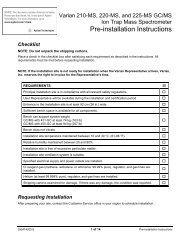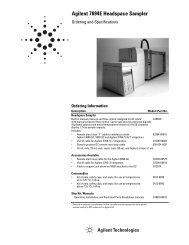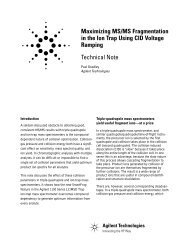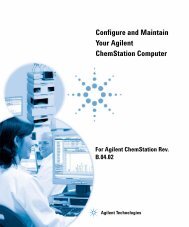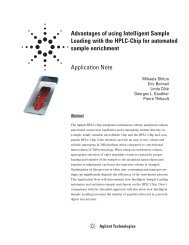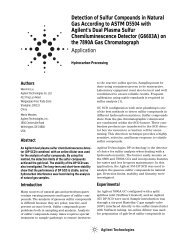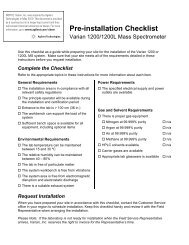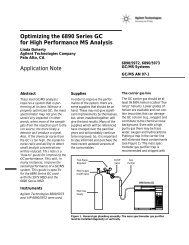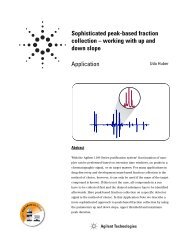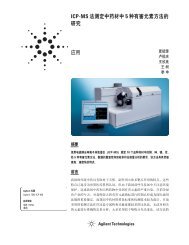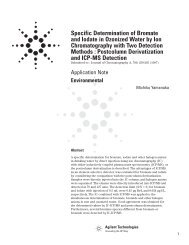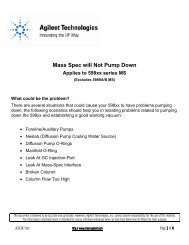UV-visible Spectroscopy As An Alterna - Agilent Technologies
UV-visible Spectroscopy As An Alterna - Agilent Technologies
UV-visible Spectroscopy As An Alterna - Agilent Technologies
Create successful ePaper yourself
Turn your PDF publications into a flip-book with our unique Google optimized e-Paper software.
<strong>UV</strong>-<strong>visible</strong> spectroscopy as an alternative<br />
to liquid chromatography as<br />
analysis method for dissolution testing<br />
Application Note<br />
Carsten Buhlmann<br />
Pharmaceutical<br />
Introduction<br />
Dissolution testing is widely used in the pharmaceutical industry to determine<br />
quality assurance parameters for batch release. Today's competitive pharmaceutical<br />
market demands high efficiency and productivity not only in manufacturing<br />
but also in routine analytical processes. In dissolution testing the majority<br />
of formulations are already analyzed by <strong>UV</strong>-<strong>visible</strong> spectroscopy, but liquid<br />
chromatography (LC) is often used for formulations containing interfering<br />
excipients or multiple ingredients.<br />
This study demonstrates that identical results can be achieved by replacing<br />
the LC method by a faster and more convenient <strong>UV</strong>-<strong>visible</strong> method. The two<br />
techniques were used in parallel for analysis of the same dissolution process<br />
to allow an exact comparison of the results. <strong>As</strong> examples, single and multicomponent<br />
pharmaceutical formulations were analyzed and were chosen<br />
because LC is the analysis method for both formulations according to United<br />
States Pharmacopeia (USP).
Experimental<br />
The dissolution tests were performed<br />
using Distek 2100B, Erweka<br />
DT80 and Hanson SR8Plus dissolution<br />
baths, which were configured<br />
according to apparatus 2,<br />
USP paddle method. A software<br />
driver supplied by the respective<br />
bath manufacturer enabled the<br />
baths to be controlled remotely by<br />
the <strong>Agilent</strong> ChemStation.<br />
Tablets for single component<br />
analysis contained warfarin (5 mg<br />
per tablet) as active ingredient<br />
and were dissolved at a stirring<br />
speed of 50 rpm. Tablets for multicomponent<br />
analysis contained<br />
acetaminophen (333 mg) and caffeine<br />
(50 mg) and were dissolved<br />
with stirring speed of 100 rpm.<br />
Water at 37 ºC was used as dissolution<br />
medium in all experiments.<br />
The <strong>UV</strong>-<strong>visible</strong> spectroscopy<br />
analyses were performed with an<br />
<strong>Agilent</strong> 8453 dissolution testing<br />
system, comprising spectrophotometer<br />
and multicell transport as<br />
sampling system. Because of the<br />
different concentrations of the<br />
active ingredients in the tablets, 1<br />
cm flow cells were used for measurement<br />
of warfarin whereas 0.1<br />
cm flow cells were used for the<br />
measurement of acetaminophen<br />
and caffeine.<br />
The liquid chromatography analyses<br />
were performed with an <strong>Agilent</strong><br />
1100 Series LC—a high performance<br />
instrument—comprising<br />
vacuum degasser, binary pump,<br />
autosampler, thermostatted column<br />
compartment and diode array<br />
detector.<br />
After each <strong>UV</strong>-<strong>visible</strong> measurement<br />
cycle, samples for LC analysis<br />
were collected directly from<br />
the flow cells. These samples were<br />
centrifuged at 15000 g and 22 ºC<br />
for 20 minutes, and the supernatant<br />
liquid was transferred to<br />
sample vials which were placed in<br />
the autosampler. The LC analyses<br />
were performed according to USP<br />
methods. 1<br />
The 8-channel multicell transport<br />
configuration of the <strong>Agilent</strong> 8453<br />
dissolution testing system enabled<br />
measurement of 6 tablets, blank<br />
and control at each measurement<br />
cycle. Each vessel was connected<br />
to a separate flow cell in a closed<br />
loop configuration.<br />
A control with known concentrations<br />
was included during all dissolution<br />
runs to verify the calibration<br />
and to check for system suitability.<br />
Initial tests with salicylic<br />
acid and prednisone USP calibrator<br />
tablets validated the dissolution<br />
bath and the <strong>UV</strong>-<strong>visible</strong> and<br />
LC methodologies.<br />
Results<br />
Single component formulations<br />
The dissolution run of the single<br />
component formulation containing<br />
warfarin was analyzed by the LC<br />
and <strong>UV</strong>-<strong>visible</strong> methods in parallel.<br />
Diode-array-based <strong>UV</strong>-<strong>visible</strong><br />
absorbance detection was used<br />
for both methods, which had the<br />
advantage of obtaining simultaneously<br />
the analytical wavelength at<br />
306 nm and a wavelength range of<br />
380 to 400 nm as internal reference.<br />
Figures 1 and 2 show the dissolution<br />
profiles of six of the tablets<br />
from the <strong>UV</strong>-<strong>visible</strong> and LC analyses<br />
respectively. During the run<br />
samples from all vessels were analyzed<br />
at 0, 5, 12, 20 and 30 minutes<br />
and the results displayed as percent-dissolved<br />
warfarin.<br />
The dissolution profiles in figure 2<br />
were generated by a spreadsheet<br />
application and show the results<br />
obtained by LC analysis and data<br />
evaluation about two and half<br />
hours after the dissolution run.<br />
In contrast the profiles in figure 1<br />
are the results of the <strong>UV</strong>-<strong>visible</strong><br />
analyses, which were generated<br />
automatically by the dissolution<br />
testing software online during the<br />
run.<br />
A comparison of the two figures<br />
reveals that the dissolution profiles<br />
obtained by the <strong>UV</strong>-<strong>visible</strong><br />
and LC methods are similar. The<br />
profiles of the individual tablets<br />
were different, which was confirmed<br />
by both analysis methods.
Dissolution [%]<br />
100<br />
80<br />
60<br />
40<br />
20<br />
0<br />
0<br />
10<br />
20 30<br />
Time [min]<br />
Figure 1<br />
Dissolution profiles from <strong>UV</strong>-<strong>visible</strong> analyses<br />
Time Vessel Average StdDev<br />
1 2 3 4 5 6 7 (Ctrl)<br />
0 0.00 0.00 0.00 0.00 0.00 0.00 63.56 0 0<br />
5 25.40 18.59 24.57 18.72 16.42 19.81 65.43 20.584 3.591<br />
12 60.69 43.75 56.46 41.99 40.55 51.82 65.34 49.208 8.342<br />
20 88.56 62.49 83.50 61.36 61.59 75.99 65.85 72.247 12.117<br />
30 106.59 81.18 106.30 82.87 78.25 96.03 65.80 91.870 12.830<br />
Table 1<br />
Dissolution results from <strong>UV</strong>-<strong>visible</strong> analyses<br />
Dissolution [%]<br />
100<br />
80<br />
60<br />
40<br />
20<br />
0<br />
0<br />
10<br />
Figure 2<br />
Dissolution profiles from LC analyses<br />
20 30<br />
Time [min]<br />
Time Vessel Average StdDev<br />
1 2 3 4 5 6 7 (Ctrl)<br />
0 0.00 0.00 0.00 0.00 0.00 0.00 n.d. 0 0<br />
5 25.25 18.08 23.91 18.48 16.52 20.13 64.30 20.393 3.465<br />
12 60.76 43.77 56.63 42.32 40.95 52.36 63.93 49.465 8.285<br />
20 88.06 62.63 83.87 62.00 61.93 76.19 65.06 72.445 11.868<br />
30 106.65 80.86 106.16 82.56 77.60 95.99 64.91 91.637 13.046<br />
Table 2<br />
Dissolution results from LC analyses<br />
For a more detailed comparison,<br />
tables 1 and 2 show the dissolution<br />
results of the two methods.<br />
The values—taken at each time<br />
point—represent percent-dissolved<br />
warfarin in the six vessels<br />
containing the different tablets<br />
and in the vessel containing the<br />
control. Further, the tables show<br />
the average values of the six<br />
tablets and the respective standard<br />
deviations.<br />
The results in table 2 for the LC<br />
analyses were generated by a<br />
spreadsheet application, whereas<br />
the results in table 1 for the <strong>UV</strong>visble<br />
analyses were generated<br />
automatically with the dissolution<br />
testing software directly after<br />
each measurement cycle. The dissolution<br />
results of both methods<br />
were equivalent with a maximum<br />
difference of 1.4 % between comparative<br />
values. The average values<br />
for the six tablets also compare<br />
well.<br />
In summary, both analysis methods<br />
were applicable for this single<br />
component formulation. However,<br />
the <strong>Agilent</strong> dissolution testing system<br />
offers more convenient online<br />
sampling and online result generation<br />
during the dissolution tests.
Multicomponent formulations<br />
<strong>An</strong> advantage of the LC method is<br />
the physical separation of formulation<br />
components during analysis.<br />
For this reason multicomponent<br />
formulations are generally<br />
analyzed by LC.<br />
This study demonstrates that<br />
accurate analysis of more complex<br />
formulations can be achieved<br />
using a diode-array-based <strong>UV</strong>-<strong>visible</strong><br />
spectrophotometer and a<br />
sophisticated multicomponent<br />
analysis (MCA) algorithm.<br />
Based on initial tests with standard<br />
solutions, a <strong>UV</strong>-<strong>visible</strong> analysis<br />
method for measuring the dissolution<br />
of the multicomponent<br />
formulation was development. To<br />
improve the quantitative accuracy,<br />
first-order derivatives were used<br />
instead of absorbance spectra. 2<br />
A first-order derivative is the rate<br />
of change of absorbance with<br />
respect to wavelength, see<br />
figure 3. Using first-order derivatives<br />
ensures correction for minor<br />
background absorbance or scattering.<br />
By applying derivative<br />
spectroscopy in this application<br />
example, wavelength ranges could<br />
be used for calibration, in which<br />
high spectral differences between<br />
both compounds were accompanied<br />
by best fit of predicted and<br />
sample spectra (262–264 nm and<br />
275–278 nm.)<br />
Absorbance [AU]<br />
d1(Absorbance)<br />
1.4<br />
1.2<br />
1.0<br />
0.8<br />
0.6<br />
0.4<br />
0.2<br />
0<br />
0.05<br />
0<br />
-0.05<br />
-0.10<br />
-0.15<br />
-0.20<br />
-0.25<br />
200<br />
200<br />
220<br />
220<br />
Caffeine<br />
240<br />
Acetaminophen<br />
240<br />
The <strong>Agilent</strong> 8453 spectrophotometer’s<br />
advantages of fast, simultaneous<br />
spectral data acquisition and<br />
excellent wavelength reproducibility<br />
could be exploited, because<br />
any wavelength in the entire <strong>UV</strong><strong>visible</strong><br />
range could be used for<br />
data evaluation.<br />
260<br />
260<br />
Figure 3<br />
Absorbance spectra (top) and first-order derivatives (bottom)<br />
Acetaminophen<br />
Caffeine<br />
280<br />
280<br />
300 320<br />
Wavelength [nm]<br />
300 320<br />
Wavelength [nm]<br />
Using a wavelength range instead<br />
of a simple, simultaneous-equations<br />
method for multicomponent<br />
analysis overcame the well-known<br />
limitations of traditional MCA. 3
The <strong>UV</strong>-<strong>visible</strong> method was validated<br />
by analyzing two series of<br />
synthetic mixtures. In each series<br />
of mixtures, the concentration of<br />
one component was kept at the<br />
same level as in the multicomponent<br />
formulation, whereas the<br />
concentration of the other component<br />
was varied from 0 to 150%.<br />
Figures 4 and 5 show the results<br />
of multicomponent analysis of the<br />
synthetic mixtures. The results<br />
confirmed the selectivity, accuracy<br />
and reproducibility of the analytical<br />
method as well as the linearity<br />
of the method for different formulation<br />
concentrations.<br />
<strong>As</strong> for SCA, the dissolution of the<br />
multicomponent formulation was<br />
analyzed in parallel by LC and <strong>UV</strong><strong>visible</strong><br />
methods. The results are<br />
illustrated by table 3 showing fast<br />
dissolution of all six tablets. The<br />
table shows percent dissolved<br />
acetaminophen and caffeine for<br />
the six tablets and the control<br />
obtained by LC and <strong>UV</strong>-<strong>visible</strong><br />
methods. The differences between<br />
these results at the three different<br />
points in time are also included.<br />
The small differences reflect the<br />
applicability of both analytical<br />
methods for the multicomponent<br />
analysis.<br />
MCA compound [%]<br />
Acetaminophen<br />
Caffeine<br />
Figure 4<br />
Influence of varying caffeine concentration on acetaminophen analysis<br />
MCA compound [%]<br />
150<br />
100<br />
50<br />
0<br />
150<br />
100<br />
50<br />
0<br />
Acetaminophen<br />
Caffeine<br />
Figure 5<br />
Influence of varying acetaminophen concentration on caffeine analysis<br />
Mixtures<br />
Mixtures
Acetaminophen [dissolved %] Caffeine [dissolved %]<br />
Tablet Time LC method <strong>UV</strong> method Difference LC method <strong>UV</strong> method Difference<br />
1 7 104.14 103.85 0.29 102.61 100.09 2.52<br />
2 7 103.50 104.39 -0.89 102.61 103.90 -1.29<br />
3 7 103.93 104.01 -0.08 105.56 107.64 -2.07<br />
4 7 104.06 104.24 -0.18 104.96 98.28 6.68<br />
5 7 104.14 103.74 0.40 99.71 100.33 -0.63<br />
6 7 103.12 103.71 -0.59 102.12 100.32 1.80<br />
Ctrl 7 58.85 59.56 -0.71 51.60 50.99 0.61<br />
1 20 104.18 104.07 0.10 103.57 101.65 1.92<br />
2 20 104.90 104.52 0.37 105.98 105.18 0.81<br />
3 20 103.42 104.15 -0.72 109.48 108.94 0.54<br />
4 20 104.23 104.25 -0.02 99.73 98.90 0.83<br />
5 20 102.99 103.91 -0.92 101.97 101.39 0.58<br />
6 20 103.28 103.64 -0.36 101.81 100.53 1.28<br />
Ctrl 20 59.38 59.62 -0.25 52.20 50.92 1.28<br />
1 60 104.68 104.33 0.35 102.99 101.57 1.43<br />
2 60 104.84 105.25 -0.41 106.60 107.18 -0.59<br />
3 60 104.07 104.60 -0.53 110.11 109.08 1.03<br />
4 60 104.39 104.45 -0.06 100.25 100.05 0.20<br />
5 60 103.80 104.27 -0.47 102.82 101.80 1.03<br />
6 60 104.91 103.93 0.98 102.21 101.02 1.18<br />
Ctrl 60 59.47 59.82 -0.35 52.49 51.64 0.85<br />
Table 3<br />
Results of LC and <strong>UV</strong>-<strong>visible</strong> analyses of the multicomponent formulation<br />
Figure 6 shows the average results<br />
from six vessels at different times<br />
and the average results of the control<br />
measurements for both components,<br />
acetaminophen (Acet)<br />
and caffeine (Caf). The error bars<br />
indicate the standard deviation of<br />
each average value. Both analytical<br />
methods gave essentially identical<br />
results for dissolution of this<br />
multicomponent formulation. The<br />
small standard deviations of the<br />
control values indicate high precision<br />
of both methods because the<br />
control did not change during the<br />
dissolution process.<br />
Average values ± Std. dev. [mg]<br />
350<br />
300<br />
250<br />
200<br />
150<br />
100<br />
50<br />
0<br />
Acet<br />
7 min<br />
Caf<br />
7 min<br />
Acet<br />
20 min<br />
Caf<br />
20 min<br />
Acet<br />
60 min<br />
Caf<br />
60 min<br />
LC Method<br />
<strong>UV</strong> Method<br />
Acet<br />
Control<br />
Caf<br />
Control<br />
Figure 6<br />
Average results for both components
Summary<br />
A <strong>UV</strong>-<strong>visible</strong> spectroscopy analysis<br />
method—with the technological<br />
advantage of simultaneous spectral<br />
data acquisition and the implementation<br />
of powerful data analysis<br />
algorithms—yielded equally<br />
good analysis results compared to<br />
a classical LC analysis method for<br />
the dissolution of single and multicomponent<br />
formulations.<br />
Further, the fast response of the<br />
<strong>UV</strong>-<strong>visible</strong> technique using the <strong>Agilent</strong><br />
8453 dissolution testing system<br />
with multicell transport provided<br />
for real-time monitoring of<br />
the dissolution process. In contrast,<br />
the LC method required several<br />
additional hours before the<br />
complete dissolution result report<br />
was available.<br />
The capabilities of the <strong>Agilent</strong><br />
8453 dissolution testing system<br />
allowed cost savings in investment<br />
and running of the instrumentation,<br />
without a loss of quality of<br />
the results. In addition, the system<br />
offered all features for automated<br />
measurement, including online<br />
monitoring of bath parameters<br />
through to report generation and<br />
evaluation of release criteria.<br />
Conclusion<br />
Modern diode-array-based <strong>UV</strong>-<strong>visible</strong><br />
spectroscopy analysis is<br />
applicable for dissolution testing<br />
in many cases where LC is the traditional<br />
analysis method. The<br />
excellent conformity of the results<br />
for the application examples<br />
examined in this study makes the<br />
<strong>Agilent</strong> 8453 dissolution testing<br />
system an ideal tool for quality<br />
control and other routine analyses<br />
in the pharmaceutical industry.<br />
References<br />
1. United States Pharmacopeia<br />
XXIV, 1999, pages 22 and 1751<br />
2. Owen, A. J., “Uses of derivative<br />
spectroscopy”, <strong>Agilent</strong> <strong>Technologies</strong><br />
Application Note, 1995, publication<br />
number 5963-3940E<br />
3. Owen, A. J., “Fundamentals of<br />
modern <strong>UV</strong>-<strong>visible</strong> spectroscopy”,<br />
<strong>Agilent</strong> <strong>Technologies</strong> Primer,<br />
1996, publication number 5965-<br />
5123E.
Carsten Buhlmann is an application<br />
chemist based at <strong>Agilent</strong><br />
<strong>Technologies</strong> GmbH, Waldbronn,<br />
Germany<br />
Copyright © 2000 <strong>Agilent</strong> <strong>Technologies</strong><br />
All Rights Reserved. Reproduction, adaptation<br />
or translation without prior written permission<br />
is prohibited, except as allowed under the<br />
copyright laws.<br />
Publication Number 5968-8810E



